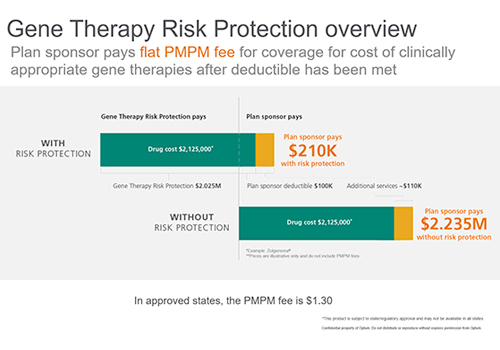Hemophilia gene therapies on the horizon in 2020
After a minor injury such as a cut or a scrape, most individuals have the natural ability to form a blood clot to halt the bleeding. But for someone with hemophilia who lacks the blood proteins (also called clotting factors) needed to stop bleeding, even small injuries can result in serious damage. In addition to excessive bleeding from accidents, people with hemophilia are also subject to spontaneous bleeding episodes as well as longer-term medical complications including anemia, and damage to muscles and joints caused by internal bleeding.
Fortunately for hemophilia patients, treatments have continued to evolve and now enable many patients to live near-normal lives with a reduced risk of serious or life-threatening bleeds. Newer forms of replacement clotting factor can be used prophylactically to prevent bleeds from occurring and have also enabled “on demand” use during bleeding episodes.1 More recently, some patients now have the option to use other hemophilia medicines for bleeding prophylaxis. Launched in 2018, the drug Hemlibra® can be used once weekly or every two weeks to reduce instances of bleeding in people with Hemophilia type A.2
However, these treatments are extremely expensive. The cost of existing drug therapy for a person with hemophilia can be several hundred thousand dollars per year and annual treatment costs of one million dollars or more are not unheard of for patients with the most severe forms of the disease.3
As existing medicines require a lifetime of administration, researchers continue to search for more durable interventions. One area of intense investigation is gene therapies.
A potential genetic fix
Gene therapies are an emerging class of drugs which introduce, remove or change sequences of genetic code to target the cause of the disease rather than just addressing symptoms. While only two gene therapies are currently in the market in the U.S., the Food and Drug Administration lists more than 900 investigational new drug (IND) applications for ongoing clinical studies of new gene therapies. 4
Since hemophilia is caused by a genetic mutation that leads to a loss of important blood clotting factors, it is a natural application for this technology.5 Ideally, a gene therapy for hemophilia would be a one-time administration that delivers a working copy of the gene responsible for producing blood clotting factors.
Several companies currently have hemophilia gene therapies in clinical studies.6 In December 2019, BioMarin Pharmaceutical Inc. announced that it had submitted an application to the U.S. Food and Drug Administration for its gene therapy for adults with hemophilia A. Their submission showed that most of the participants exhibited “substantial reductions” in the incidence of bleeding events. Significantly, participants were also able to stop using preventive dosing with clotting factor, with minimal need for on-demand treatment of acute bleeding episodes.7
This may seem encouraging. Yet, the study’s small sample size and limited time frame serve to underscore how much we still don’t know about the efficacy and durability of this or other hemophilia gene therapies and how applicable they will be for a broader population.8
Addressing cost concerns
These study results are apparently sufficient to cause widespread expectations that this gene therapy will be approved sometime in 2020.9
Accordingly, it is not too soon to start considering questions about the potential costs of hemophilia gene therapies. Speaking recently at a healthcare conference, BioMarin CEO Jean-Jacques Bienaimé said the company was considering a price between two million dollars and three million dollars for its gene therapy.10 While it is important to consider this price in context of the cumulative costs of existing hemophilia therapies, a price at the top end of range would make the drug the most expensive in history.
Gene therapy is very promising, but it unlikely to be the best solution for all patients with hemophilia. It will be expensive; ensuring the right patients get access to it and maximizing the potential benefits while maintaining affordability will be challenging.
That is why OptumRx uses a comprehensive approach that employs several strategies specifically designed to properly manage high-cost specialty medications and rests on the combined expertise of OptumRx pharmacists, physician specialists, and pharmacotherapy experts. What’s more, our independent OptumRx Pharmacy and Therapeutics Committee evaluates new technologies using rigorous evidence-based clinical evaluations.
In addition to addressing the cost and appropriate use of the medications, OptumRx has developed a holistic approach to treating patients with hemophilia. Optum Therapy Solutions for Hemophilia and Bleeding Disorders ensure consistent management and care coordination for patients with hemophilia. Our care managers know hemophilia and what patients and their providers need in order to manage it effectively.This end-to-end service model helps keep patients healthy and lowers total cost of care.
Related content
References:
1. Haemophilia. “Haemophilia care then, now and in the future.” Accessed at: https://onlinelibrary.wiley.com/doi/full/10.1111/j.1365-2516.2008.01946.x
2. American Society of Hematology. “626 Bone and Joint Health Markers in Persons with Hemophilia A (PwHA) Treated with Emicizumab in HAVEN 3” Accessed at: https://ash.confex.com/ash/2019/webprogram/Paper123689.html
3. NPR. “Miracle Of Hemophilia Drugs Comes At A Steep Price.” Accessed at: https://www.npr.org/sections/health-shots/2018/03/05/589469361/miracle-of-hemophilia-drugs-comes-at-a-steep-price
4. U.S. Food and Drug Administration. “FDA Continues Strong Support of Innovation in Development of Gene Therapy Products.” Accessed at : https://www.fda.gov/news-events/press-announcements/fda-continues-strong-support-innovation-development-gene-therapy-products
5. American Society of Hematology. “Breakthroughs in Gene Therapy for Hemophilia.” Accessed at: https://www.ashclinicalnews.org/spotlight/breakthroughs-gene-therapy-hemophilia/
6. American Society of Gene & Cell Therapy. “Clinical Trials Finder.” Accessed at: https://app.emergingmed.com/asgct/home/:diseaseId%3F/:subDiseaseId%3F
7. New England Journal of Medicine. “Multiyear Follow-up of AAV5-hFVIII-SQ Gene Therapy for Hemophilia A.” Accessed at: https://www.nejm.org/doi/full/10.1056/NEJMoa1908490
8. Therapeutic Advances in Hematology. “Gene therapy for hemophilia: what does the future hold?” Accessed at: https://www.ncbi.nlm.nih.gov/pmc/articles/PMC6130099/
9. Hemophilia News Today. “Valrox, Potential Hemophilia A Gene Therapy, May Cost Up to $3 Million, BioMarin Says.” Accessed at: https://hemophilianewstoday.com/2020/01/20/biomarin-weighing-2-million-to-3-million-price-for-valrox-hemophilia-a-gene-therapy/
10. Wall Street Journal. “BioMarin Explores Pricing Experimental Gene Therapy at $2 Million to $3 Million.” Accessed at: https://www.wsj.com/articles/biomarin-explores-pricing-experimental-gene-therapy-at-2-million-to-3-million-11579190318
STATEMENT REGARDING FINANCIAL INFLUENCE:
This article is directed solely to its intended audience about important developments affecting the pharmacy benefits business. It is not intended to promote the use of any drug mentioned in the article and neither the author nor OptumRx has accepted any form of compensation for the preparation or distribution of this article.



